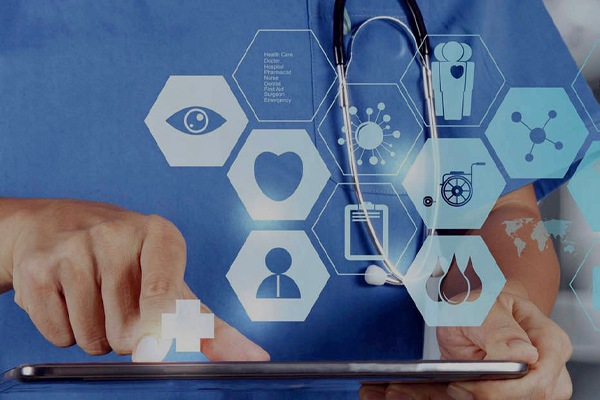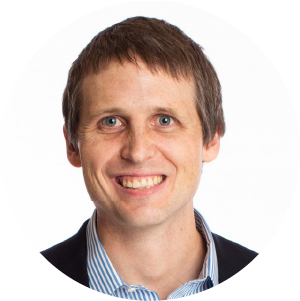The business of digital health

The business of digital health
July 28, 2021 | By Dr. Michael Hasselberg
The healthcare industry is “ripe for disruption” for business-minded innovators, according to Dr. Michael Hasselberg, UR Health’s first Senior Director of Digital Health. In this Q&A, Michael shares his insights about ongoing successes, challenges, and opportunities for collaboration in his mission to reshape the digital landscape at UR Medicine.
How did you come into this new role?
When COVID-19 hit, the need to treat patients in their homes made telemedicine and digital health initiatives more vital than ever. What we quickly learned at UR Medicine was that we lacked the vision and strategy we needed to become a fully technology-enabled health system. We were managing digital requests from various departments in our system in a very reactive way, and our clinical and operational resources were being stretched thin.
Dr. Mike Rotundo, the CEO of the UR Medical Faculty Group that represents our ambulatory service lines, identified the gap and offered me a role as the health system’s first Senior Director for Digital Health. At the time, I was already co-directing the UR Health Lab, which is tasked with transforming care delivery through the use of technologies like virtual and augmented reality technologies, artificial intelligence, web-based chat applications, and smartphone mobile applications. By accepting this additional role, I took on the challenge of developing and implementing a digital-first strategy that would transform “care as usual” into a technology-enabled health system over the next five years. Currently, I spend half my time co-directing the UR Health Lab and the other half working on high-level strategy and vision.
What are some of the recent successes and challenges you’ve encountered in introducing new technology at UR Health?
Every technology we explore has the potential to work well and work poorly in different contexts. Machine learning is a great example. When it comes to radiology, machine learning technology can alert a radiologist to abnormalities or patterns in images that shouldn’t be there. In this case, machine learning works well because the images are relatively consistent. We use the same camera, same colors, and same lighting for each one.
On the flip side of the coin, machine learning applications have a difficult time making sense of data that is less straightforward. Unlike spaces like the financial industry, where data representing things like credit scores and loan risks is relatively systematic and clean, healthcare data is messy and noisy. Every patient’s Electronic Health Record (EHR) contains a collection of subjective notes that translate less readily into usable data. Some of the information in the EHR will also be inaccurate or outdated. When the UH Health Lab was tasked with using natural language processing to sort the data in the EHR so that certain patient messages go to a nurse, others to a receptionist, and others to a primary care physician, for example, we found that the data was so heterogeneous that the computer was unable to identify clear patterns.
Another issue we face is that patient data is scattered across the healthcare system. To make total sense of the patient experience, we have to put all our data in one place in order to understand what’s useful and what’s not. To this end, we’re currently working on an enterprise data warehouse for our medical center that will house all our data under one roof. We have significant progress to make, but this initiative is a step in the right direction.
How will you improve public trust in digital health in an age of data breaches and privacy violations?
One of the things we do best in healthcare is to protect patient data. At UR Medicine, our servers are on-premises, so none of our health data is up in the cloud. I would argue that our health data is safer than more personal information we’re sending via email or posting on social media. There is actually a greater push toward loosening restrictions on access to data to provide greater transparency for patients. We support a national movement called OpenNotes, which encourages physicians to give patients access to everything that goes into the Electronic Health Record. As a result of implementing these changes, we’re having more fruitful, open discussions with patients about their health.
What are some lessons learned from the past year of telehealth, and how do you see telehealth playing a role in care delivery going forward?
What we learned during the COVID-19 pandemic was that a lot of what we do face-to-face, we can do just as well via video conferencing. After the outbreak, we were able to pivot quickly to offer telehealth appoints, and our patients expressed a high level of satisfaction with the technology. Our healthcare providers went from doing approximately 100 telehealth consults a day in early March 2020 to between 6,000 and 7,000 only a week later. At one point, close to 60 percent of what we were doing in the health system was via telehealth.
Today, our telehealth numbers are quickly declining at the medical center, but not because patients aren’t demanding it. We’re increasingly seeing our patients place a high value on the convenience of the telehealth experience. They don’t have to take time off work, fight for parking, and sit in a waiting room with potential infection transmission risks. Instead, the decline we’re experiencing reflects the way we get paid as a health system. While many of our West Coast counterparts are moving to a system that is more value-based than fee-for-service, health systems in our region are still reimbursed by payers who prioritize high occupancy rates and keeping surgeons operating over keeping patients in their homes and out of high-cost procedures. We are starting to see a push for reimbursement parity between telehealth and in-person care at the state and federal levels, but I don’t envision that telehealth will become more mainstream until our larger reimbursement structure changes.
What is the role of interdisciplinary collaboration in digital transformation at UR Medicine?
We’re one of only a handful of academic medical centers in the country that roll up to a single budget, which means we have a unique opportunity to leverage expertise from other faculties. Essentially, the UR Health Lab serves as our health system’s digital health incubator. When our senior leadership identifies gaps in patient care or provider efficiency that technology can fill, we identify industry solutions or build new technology ourselves. That process wouldn’t be possible without a multidisciplinary team that includes faculty members from engineering, data science, music, and business as well as clinical faculty across medical disciplines.
How can faculty members and students at the Simon School of Business support and augment your team’s efforts?
At UR Medicine, there are countless opportunities for business-minded people to help advance our mission. We are a group of clinicians and software developers and data scientists, not business people. One way our friends at Simon can lend their expertise is to help us develop opportunities for commercialization for the technologies that we develop in the UR Health Lab.
You can also help us think strategically about investing and negotiating as we continue to onboard tech startups who are looking for a partner to test and co-develop their technology. As digital health grows and we continue to partner with industry and develop our own technologies, we could really use students and faculty at Simon to help us navigate these unknown waters.

Dr. Michael Hasselberg is the Senior Director of Digital Health at the University of Rochester Medical Center (UR Health).
To view other blogs in this series, visit the Dean's Corner Main Page











